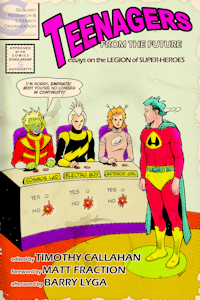When I first read Urasawa’s 20th Century Boys: Friends, I stopped after the initial six pages and put the book away. For they were so perfect in themselves, so wonderfully concise and clever and moving, that I was scared to read on. Who’d want an opening chapter which was that smart and touching spoilt by anything of a lesser quality following on afterwards? Sometimes it’s best to just adore the single and not get bogged down in the album, to enjoy the stand-out episode and resist the temptation of the box-set.
I couldn’t resist for long, of course. Despite the intense suspicion that the next 200 pages could only be a disappointment, and that the subsequent two dozen or so volumes of 20th Century Boys would quickly reveal themselves to be a wearisome and expensive grind, I tip-toed my cynical way into chapter two and found that the story proper seemed at first to be perfectly competent. Another entirely gratuitous panty shot, mind you, and a sense of set-up over-riding story for the first few pages, but by the time professional underachiever and good-guy baby-minder Kenji was center stage, even the skeptical reader had to concede that this was more than just a good comic. For 20th Century Boys is, just as everyone before me has quite rightly declared, a bloody marvel.
For anyone with ambitions to be an outstanding comics professional, I suspect that Urasawa’s work on this first volume of 20th Century Boys must depress almost as much as it inspires. For his evident virtuosity is always modestly placed in service of the narrative, and the sophistication and excellence of his storytelling appears so natural and unselfconscious that it’s hard to come to terms with how brilliantly judged and unpretentiously ambitious the story is. Apparently undemanding and yet both genuinely affecting and endlessly smart-minded, 20th Century Boys is an exemplar of how comics can speak to the broadest of audiences without sacrificing an iota of ambition, emotion or intelligence. The story shifts from parallel narratives in different time periods and from one genre to another without the slightest sense of artifice or jarring. Just to focus on the sequences concerning the young Kenji and his friends in their secret semi-rural hideout is to realise that Urasawa’s work has the same capacity to evoke the details and meaning of everyday experience in a pop context as a Dickens or a King. It is, as I said, a bloody marvel.
Yet putting all that entirely appropriate awe to one side, what’s perhaps most telling about Urasawa’s storytelling is how scrupulously precise the fine detail of it is. In that, the most basic of the building blocks present in Urasawa’s work communicates his intentions in such a meticulously exacting fashion that it’s practically impossible for the reader to loose their way despite all of the complexity and audacity of the broader narrative. Nowhere is this as true as it is on his less apparently eye catching pages, where it might be expected that the more static and less intense scenes at hand could inspire the reader to yawn and skip forwards. Yet no matter how quiet and apparently uninvolving a page might at first threaten to be, it always holds and repays the reader’s attention. In short, all of that genius is anchored in a constant attention to the absolute fundamentals, as genius, of course, always is.
On page 166 of 20th Century Boys: Friends, for example, Urasawa shows once again how he’s never complacent in the manner in which he establishes the facts of a scene, just as he’s never arrogant when it comes to developing the most elegant if unshowy way of furthering the plot while maintaining the reader’s involvement. As the eye enters the page from the top-right, the reader’s immediately informed of exactly where the book’s cast have been placed. Beyond that essential business, the establishing shot might appear at first to be untypically empty of interest, but, of course, nothing could be further from the truth. Five childhood friends have gathered at night to attempt to solve a puzzle whose solution appears to have something to do with their youthful and long built-over stomping grounds. Deliberately ignoring the convention that characters should be placed to one side or another of a frame, Kenji and his friends have been crowded uncomfortably together in the middle of the panel. Their awkward body language, all hands in pockets and passive stances, expresses how out of place and melancholic they feel. At the same time, their sense of helplessness is further established by the way in which the vertical lines of the building before them pin the friends together in their common powerlessness behind the fence and at the edges of the light, excluded from the ground which they once regarded as theirs. The flats are never made to seem impressive or important in themselves, for that would undermine the tawdry fact of what’s happened to the friend’s childhood playground, but the building still towers over them, with its roof and the sky behind it having been tellingly excluded from the frame. Even the lifelessness of the apartments helps to underscore the fact that what was once a place of childhood wonder has been reduced to a characterless, excluding obstacle
Similarly, the cropping of the bottom of the panel is exquisitely judged, with the character’s feet being as claustrophobically close to the edge of the frame as is feasible, miring them in ineffectiveness. This is a panel whose gravity seems to hold all five men irresistibly in a place where they count for nothing and where their freedom of action is conspicuously limited. For these are characters, the panel wordlessly reminds us, who’ve not just lost much of their youthful spirit and dreams, but their memories too. They’ve ended up in this soulless place in what seems like a futile attempt to uncover perhaps perpetually irrecoverable memories, and they’re looking out not just at what is, but what once was. They’re baffled supplicants, if you will, outside a church which is purposefully designed to exclude them, and there can’t be many of us who would fail to empathise with their predicament, who haven’t returned to an old haunt and found not just the environment changed, but all the ghosts gone too, except for ourselves.
Nothing much is happening, or so it seems, and yet the very first page of Urasawa’s 20th Century Boys: Friends is as enchanting as it’s compelling. That Urasawa achieves this without the slightest obvious visual sign of conflict and jeopardy in his narrative is a mark of his genius. After all, a brief description of these six panels would be unlikely to inspire enthusiasm amongst those unfamiliar with Urasawa’s work. First there’s an establishing shot of a Japanese school, an external view of characterless classroom windows overlooking an unused football pitch. Then, a row of three close-ups showing students during their lunch-break, with the most dramatic panel presenting two lads taking an enthusiastic, if hardly boisterous, interest in a copy of Heibon Punch, a men’s magazine. Finally, we’re presented with a view of the calm dining room in which the children sit, before we finally exit the side with a frame dedicated to an entirely unremarkable wall-mounted speaker. It’s not, you might imagine, the most promising of tale-opening scenarios.
Urasawa creates a perfectly subtle snare of an opening panel by juxtaposing the actionless exterior shot of the apparently deserted school with an intriguingly unattributed caption stating “I thought something would change.” Doing so forces the reader from the off to ask questions of the story rather than waiting to be told what’s going on. Who’s speaking? Why did they expect change to occur? Why didn’t it come about? What’s so important about the scene-setting date of 1973? The eye searches for the slightest clue, and yet the panel suggests nothing except for the suspicion that the very placidity of the situation might be to blame for the hope of something happening. Even the wire-mesh fence around the football pitch comes to an end as the reader’s eye reaches the far-left of the panel, meaning that there’s not even a hint that this is more a hemmed-in prison camp than school. Escape, it seems, would be as easy a matter as walking out of the front door. As such, Urasawa begins 20th Century Boys with a sense of quiescence and drowsiness coloured by dissatisfaction, which immediately establishes the book’s theme of how difficult it is for individual longing to co-exist with mundane reality.
The following three frames, showing absolutely typical students enjoying their break, appear to confirm that there’s nothing out-of-place here. Each panel in the sequence emphasises not just their individual personalities, but the fact of their freedom too. There’s no obvious bullying or snottiness, no teachers stamping on the slightest expression of individuality, no sign of why change might have been expected, or even of why it might have been longed for. If the outside of the school suggested an unremarkable, characterless world, then this row of panels reassures us that nothing so alienating can be true. Each shot in the row presents us with a greater measure of sociability on the part of Urasawa’s subjects, lending the page a sudden sense of momentum and joy. From the boy choosing to focus on nothing but his food, through the girls quite clearly enjoying each other’s company as they eat, to the lads for whom food is evidently less important than more carnal concerns, Urasawa contrasts the school’s silent exterior with the friendly hubbub inside its walls.
It’s the fifth panel which resolves the apparent contradiction between the empty school grounds and the institution’s sociable interior, between its amiable students and the voice-over suggesting what just might be frustration and boredom. Presenting us with a wide, high-angle shot of the dining room, Urasawa suddenly shows us how compliant the students are. No-one is moving around, no-one is standing, no-one is thinking of doing anything more daring than to talk to a friend at another table.In the complete absence of adult supervision, we’re made aware that these are children who’ve so completely internalised the things that are expected of them that they don’t need to be told to behave. They police themselves, and within the rules that they’re barely if at all aware of, they act as if this were the only world that there might be. It’s a youthful society made peaceful through the invisible, iron hand of conformity, safe but unchallenged, peacable and yet constricting and confining. We watch the scene as if we were the adults who’d laid down the expectations for these students, the high angle of the shot lending us a sense of the power which the school’s teachers carry even in their absence. And over the student’s heads hang effect balloons each carrying no more than two unthreatening, limp notes, the meaningless components of the calming mood music which pumps from the speaker in the page’s final frame. These are students programmed not to think for themselves, content with their safe and uninspiring lot, happy and yet in so many ways barely awake. It’s the smartest, least showy, most compact expression of what homogeneity actually means that I can recall ever experiencing, and of course, it sets up perfectly both the act of hopeful, cruel and futile rebellion which follows and the lack of response which it earns.
Six largely-wordless panels to express a sense of homogeneity and alienation while ensuring that the reader feels compelled to turn the page and move on? That’s quite simply the expression of genius.
.





















































